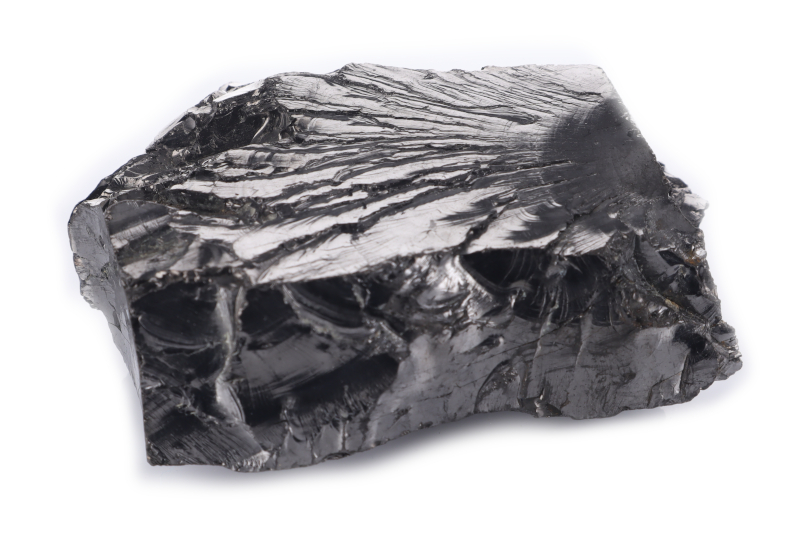Shungite research and studies
The structure and composition of natural carbonaceous fullerene containing mineral Shungite
Oleg Mosin
Moscow State University of Applied Biotechnology, Moscow 119554, Russia
Ignat Ignatov
Scientific Research Center of Medical Biophysics, Sofia 1111, Bulgaria
The review of this article
Researchers studied the composition and structural properties of amorphous, fullerene analogous carbon-containing shungite mineral from the Zazhoginskoe deposit in Karelia (Russian Federation). In this report, there is submitted information about the nanostructure, obtained using composition, scanning electron microscopy, and chemical-physical characteristics of this mineral. There’s also a demonstration prospect of using shungite natural mineral possessing high absorption, bacterial and catalytic activity, as an adsorbent for water purification and treatment.
Introduction
Shungite is a natural mineral sorbent, an intermediate form between the amorphous carbon and the graphite containing 20% silicate mica, 30% carbon, and 45% silica. Schungite carbon is a fossil organic material found at the sea bottom of the Precambrian deposits and consists of a high level of carbon and fullerene-like structures.
Initially, the shungite mineral acted as a substitute and a filler of fuel in the blast furnace production of iron, in ferroalloys melting, and in the manufacture of non-stick, heat-resistant coatings and paints. But, currently, the mineral has some other properties such as bactericidal, catalytic, reduction-oxidation, absorptional, and the ability to screen off radio radiations and electromagnetic. As a result, the mineral has a lot of uses in many industries, branches of science, and technology for the manufacturing of nanotechnological material materials with nano-molecular shape. These properties of the mineral have helped in the creation of new fillers and conductive paints for plastic materials, composite materials, carbon black, and rubber substitutes among others.
Because of having catalytic, absorptional, and reduction-oxidation property, shungite is mainly vital in water purification and treatment such as sewage in the treatment of sewage waters from both organic and inorganic substances. The mineral has greatly helped in dealing with bacteria and other biological activities.
A variety of properties and unique structure of shungite defines the search for new locations of industrial application of this natural mineral in both science and technology which contributes to a clear understanding of its structure using modern analytical techniques. This report deals with investigating and evaluating the structure, and composition of shungite mineral.
Materials
The experiment was performed using samples of shungite mineral obtained from Zazhoginsky sediments. Samples were then taken and analyzed in solid form as directed by The National standard of the Russian Federal Agency of Technical Regulation and Metrology. Samples were placed into 100cm3 hermetically sealed glass tubes after being washed and dried in a crucible furnace and homogenized in a homogenizer through mechanical grinding. The microwave helped in the decomposition of the shungite samples. Other methods used in sample preparation were drying, washing with distilled water, and pulverisette 16(Fritsch GMBH, Germany).
Analytical methods
The analytical methods got certified by the Institute of Geology of Ore Deposits. Mineralogy, Petrography, and Geochemistry which is the Russian Academy of Sciences. The collected samples were treated using GC, SEM, ICP-OES, and TEM techniques.
Inductively coupled plasma optical emission spectrometry(ICP-OES)
In this method, the mineral composition was studied using ICP-OES on Agilent 710-OES spectrometer with plasma atomizer, 40 MHz free-running air-cooled RF generator, Mega; Pixel CCD detector, and a computer-optimized system. The power output was 700-1500W in 50W increments while 1676-785nm spectral range.
Gas chromatography
The method was performed at the Main Testing Centre of Drinking Water on Kristall 4000 LUX using Inerton-DMCS columns of stationary phases of 5% OV-17 and 5% SE-30 having FID and using Helium as a carrier gas.
The total amount of carbon found in the mineral was measured using the elemental analyzer CHS-580 which has an IR detector and an electric furnace. The 200mg solid sample was subjected to combustion at the temperature of 1500.
Scan and transmission electron microscopy
The structural studies of the mineral were carried out using TEM and SEM techniques. SEM has a tungsten electron gun, a termolecular pump, and pressure.
Results and Discussion
Composition and structural properties of shungite
According to the results, shungite is a metastable allotropic form of carbon having high carbonization. Also, apart from carbon, other compounds were found from the shungite and they include SiO2-57%, Al2O3-4%, FeO-0.6%, TiO2-0.2%, MgO-1.2%, Fe2O3-1.49%, MnO-0.15%, S-1.2%, and K2O-1.5%. The compounds obtained after thermal decomposition of the shungite mineral at a temperature of 1200-1400 were found to be in smaller amounts, and they include B-0.004%, V-0.015%, Ni-0.0085%, Cu–0.0037%, Co-0.00014%, Mo-0.0031%, Zn-0.0067%, and As-0.00035%.
Physical and chemical properties of shungite
Density-2.1-2.4g/cm3
Compressive strength-1000-1200kgf/cm2
Thermal conductivity coefficient-3.8W/m K
Porosity-up to 5%
Adsorption capacity-20g/m2
Shungite mineral with silicate is divided into low carbon,-5%, medium-5-25%, and high carbon-25-80%.
The crushed crystals of shungite have bipolar properties hence high adhesion, and faster mixing of both organic and inorganic substances.
The mineral has a broad spectrum of bactericidal properties.
Carbonaceous matter of shungite having a marked anisotropy shows a significant increase in diamagnetism at low temperature, a feature for fullerites. The mineral has a hollow carbon fullerene-like multilayer spherical having smoothly curved carbon layers that cove nanopores.
The discovery of fullerenes in shungite, graphite, and carbon was through the laser irradiation process. In coal, its arrangement was at vertices of regular hexagons and pentagons, while it covered the surface of the graphite-forming an ellipsoid hence making up the closed polyhedra consisting of 3 coordinated even number of carbon atoms in sp2 hybridization state. In the carbonaceous material of shungite, there’s the presence of fullerenes and fullerene-like structures.
Fullerenes are the most excellent fillers and absorbents because of having reticulated- spherical structure and their synthetic derivatives. They are highly electronegative hence act as potent oxidizing agents.
Use of shungite in water treatment technologies
The mechanism of interaction of shungite mineral with water involves the mineral absorbing oxygen and interact with it as an active oxidizing agent in both water and air. In this process, there’s a production of atomic oxygen which acts as an active oxidizing agent hence oxidizes adsorbed found on the shungite mineral producing water and CO2. As a result, it frees the surface of the crystal allowing it to prepare for new adsorption. Extreme exposure of shungite mineral with respect to the dissolved cations such as calcium and magnesium is because metals are always transferred through the catalytic process by the crystal into insoluble carbonates.
According to the data obtained, on the absorption capacity of the mineral, it was discovered that shungite loses its effectiveness before the highly activated carbon begins to filter in the first stage of filtration. But, within 24hours, the natural shungite starts to purify water at a very high but constant rate because of its catalytic characteristic.
Also, shungite can remove free radicals from water 30 times more than activated carbon. Hence reduces the effect that might have caused by chlorine and its derivatives to human health. Besides, it’s capable of purifying sewage water by adsorbing on the surface of the contaminants hence removing colour and turbidity. As a result, it provides water with high organoleptic qualities and filling it with both macro and microelements.
Furthermore, the bactericidal property of the mineral helps in fighting against pathogens present in water; thus, used in water purification and treatment technologies.
Conclusion
From the researched data, fullerene containing natural shungite mineral has a significant practical application in a variety of industries as well as branches of science. Also, it can act as a substitute for carbon soot especially during the production of composition and construction materials, fillers, paints, and rubber. Fullerenes found in shungite mineral can also act as an alternative to the highly activated carbon during water treatment. The effectiveness of using shungite is due to its unique properties such as catalytic, adsorption, regenerative, and antibacterial, healthy to the environment with low cost of manufactured materials, and the existence of large domestic raw material site of the mineral deposit. All these features are a more significant contribution to further the expounding of shungite mineral and a lot of materials basing on them.
Reference
View full-text https://rspublication.com/ijst/dec13/2.pdf
Shungite influence on the water chemistry
A. Z Zaidenberg
Institute of Geology, Karelian Research Center, Russian Academy of Sciences, Petrozavodsk, Russia 185610
Introduction:
The Proterozoic rocks of the Shunga district (Karelia, Russia) have attracted interest for over one century because of their high carbon contents and unusual C forms. In addition to their geological fascination, shungites have properties that make them industrially interesting [ 1].
Shungite applications in adsorption of organic matter, bacterial and heavy metal removal, drinking water preparation was widely elaborated in Russia. A hypothesis concerning the role of shungite rocks in natural water systems recovering was also suggested [2].
Nevertheless, up to now the nature of shungite influence on water chemistry is not quite clear.
The most prominent features of shungite/water interaction are the following: pH alteration, extraction of metals and organic, the formation of colloidal systems.
Results and Discussion
The most pronounced effects in water treatment were noticed for the so-called ‘type III’ shungite from the Maksovo-Zazhogino deposit (Sh III). This rock is characterized by the inseparability of carbon and mineral parts and the following content (wt.%) •
C (20-32), SiO2 (57.0 -66.2), A1203 (3.20-4.45), TiO2 (0.16 – 0.3), Fe203 +FeO (1.0 – 2.3), MgO (0.4 – 0.8), CAO(0.07-0.3), K20(0.8- 1.6), Na20(0.11-0.3), MnO (0.01- 0.02), S (0.2 – 0.7).
The specific surface area measured by the N2 adsorption BET technique is about 25 m 2 g-1. Neutral solutions became more acidic after contact with Shungite III. The pH decrease up to 3.8-4.4, depending on the particle size and the Shungite – water contact conditions were found. Among possible reasons the following might take place: the influence of surface groups, catalytic destruction of organic substances [3], and also electrochemical reactions, in particular [4]
4Fe(III) + C + H20 – CO2 +4Fe(II) +4H
C (O)ads + OH— CO2 +21-1 + +3e
C (O)ads + OH — C +H202 + e
Extraction of elements from Shungite III under different conditions such as exposure time, electrolyte content and concentration was
investigated. Among the most intensively extracted substances Ca, Mg, Fe, Mn, Ni, AI, SO4, C1, S were found. It was also shown that thermal treatment as well as fine grinding influence greatly on the character of the extraction process. In particular, an increase of Na and K and a decrease of AI, Fe, Ni, Cr, V extraction were noticed under both kinds of treatment.
Formation of colloidal systems is possible as a result of AI, Fc, and SO4 presence in water contacted with Shungite III. However, the most unusual colloid is formed due to the Shungite rock ‘dissolution’, so that each micron-sized colloidal particle includes carbon and mineral parts. The close connection between carbon and minerals is the very specific feature of shungite rocks which might reflect shungite origin from carbon- silicone precursor [1]. We assumed that this feature would allow us to use shungite in the treatment of oily wastes. Indeed, we found it possible to clean water from oil up to a very high level – 0.02 – 0.05 mg/1. In this case adsorption capacity was about 60-100 mg/g and the water /sorbent ratio was as high as (1000-1500) : 1, depending on the condition of the process.
Electrochemical treatment of the Shungite filters is possible because of Shungite rocks’ high conductivity.ty (1000 S m ~ ) [5}. The later also allows us to use Electrochemical Impedance Spectroscopy methods [6] to control conditions of the process, such as electrolyte concentration, velocity, and also pressure applied to the shungite filter. We found that one can strongly increase the pH alternation and extraction of Fe(II)as a result of 2-10 V dc. polarization (figure 1).

Figure 1. pH and Fe(II) vs. time plots for 2, 4, 6 V shungite filter polarization
Obtained data allowed us to use Shungite III as electrode material in flow-type electrolyzers for drinking water preparation and heavy metals (copper, nickel, cobalt, zinc) removal.

Figure 2. Power consumption vs. time plots for heavy metals electrodeposition process.
In the latter case, about 90% of metals were removed from sulphate solutions and 100% of nickel was precipitated in a water-ammonia solution. Practically a complete extraction of cobalt and zinc was achieved with a power consumption shown in figure 2. In addition to the above reduction of Cr (VI)to 10-100 times less toxic Cr (III) was pointed. The latter allows us to elaborate on a practical system for Cr (VI) removal. The main advantages of the system are the following: I) using low-cost adsorbent made of Sh III rock and timber industry waste products combination, 2) elimination of the pH adjustment step, 3) easy utilization of the exhausted adsorbent by thermal oxidation. The ash containing up to 90 wt.% chrome (III) oxide can be used in metallurgy as an abrasive and pigment.
Conclusions
The results allow us to use shungite as a new carbon-mineral adsorbent and also utilize its specific properties: pH alteration, the formation of the colloid systems and high electroconductivity in flow-type electrolyzers for heavy metals removal.
Acknowledgments
The study was supported by the Russian Foundation for Intellectual Collaboration (grant “Shungite’).
References
1. Kalinin, Yu.K., Proc. Of the All-Union Society of Mineralogy, CXIX, NS, 1990, 1-8 (in Russ.)
2. ~ev, E.F, Kalinin, Yu.K., Zaguralskaya, L.M., Zaidenberg, A.Z., in Geology and Protection of Mineral Wealth of Karelia. Karelian Research Center, Russ..Acad. of Sci., Petrozavodsk, 1992, p. 20 (in Russ.).
3. Kalinin, A.I., Theoretical basis for self recovering processes of contaminated water. Proc. St. Petersburg Center of Ecological Security.
4. Zaidenberg, A.Z.,. Bormatov, A.A., Beloshapkin, A.A., Dyukkiev, E.F, in Engineering Problems in Ecology, (Ext. Abstr. Ira. Conf.), Vologda, Russia, 1993, pp. 15-21 (in Russ.).
5. Parfenyeva, L.S., Smimov, I.A, Zaidenberg, A.Z., Rozhkova, N.N., Stefanovich, G.B., Russ. Phys. Sol. State, 1994, 36, pp.234-236
6. Solovov, V.K., Tupolev, A.G., Zaidenberg, A.Z., Zverev, A.A., Kalinin Yu.K., in MICC-90 Moscow International Composites Conference, ed. I.N. Fridlyander, V.I. Kostikov. Elsvier Applied Science. London and NY, 1991. pp. 1343- 1347.
http://www.acs.omnibooksonline.com/data/papers/1997_ii118.pdf
Research Influence of Shungite on
Mountain Water from Bulgaria
Ignat Ignatov, Oleg Mosin
Scientific Research Center of Medical Biophysics (SRCMB), N. Kopernik Street, 32, Sofia 1111, Bulgaria
Biotechnology Department, Moscow State University of Applied Biotechnology, Talalikhina Street, 33, Moscow 109316, Russian Federation
Our review
A study was conducted to determine the structure and composition of a natural mineral with a high concentration of carbon known as shungite. Samples of the mineral were obtained from Its Zazhoginskoe deposits in Karelia (Russian Federation). The study also demonstrated the potential of the mineral to be used as an adsorbent in the water treatment and purification industry because of its high absorption capacity. The aim of this project was to investigate the effects of Shungite on mountain water obtained from Bulgaria.
Background Information
Shungite is an intermediary between graphite and amorphous carbon. The mineral was named after the Shunga village in Karelia (popularly known as the Russian Federation). The total reserve of this mineral at its Zazhoginsky deposits is approximately thirty-five million tons. But the production capacity of the plant that is processing and mining it is two hundred thousand tons annually.
This natural mineral has several applications in the manufacturing industry. It was first used to substitute carbon coke in the manufacture of cast iron. It contains valuable bactericidal, reduction-oxidation, and adsorption properties and its ability to reduce radio and electromagnetic radiations. These features have made the mineral to be used in technology, industry, and science. The catalytic, reduction-oxidation and adsorption properties of the mineral are useful in water purification and treatment technologies.
Materials and Methods
The research was using samples of the mineral that were obtained from Zazhoginsky deposits (Karelia, Russia). These samples were analyzed according to the National Standard of the Russian Federation of Technical Regulation and Metrology. They were put into glass tubes of 100 cubic centimetres after they were washed with dist.
-Analytical methods
The analytical techniques used were approved by the Institute of Geology of Ore Deposits.
-Gas-Chromatography
These tests were done at Main Testing Centre for Drinking Water using AW-DMCS chromatin and Helium gas.
-Elemental Analysis
The concentration of carbon in Shungite was measured based on ISO 29541 standards by employing elemental analyzer CHS-580, equipped with an IR-detector and electric furnace that burnt the 200 mg of the sample in the presence of oxygen at 1500 degrees Celsius.
Structural properties of Shungite
According to the research conducted, it was found out that the mineral has a high concentration of carbon compared to graphite. The fine particles of the mineral have excellent bipolar properties. This gives the mineral the ability to mix with other inorganic and organic substances. The great features of Shungite are defined by the composition and nanostructure of its elements. The carbon is distributed in quartz crystals.
The carbonaceous nature of this mineral is a result of hydrocarbon carbonization. X-ray studies the molecular structure of this mineral is shown by uncrystallized carbon, which is close to carbon black and graphite.
Effects of Shungite on Deionized Water
By measuring the IR spectra, you can obtain the following data:
– The structural framework, especially the lattice ratio
– Nature of the fundamental groups surface, which act as catalytically and active adsorption sites.
One way of obtaining information about the hydrogen bonds energy in liquid form is by measuring the entire spectrum in a liquid state.
Shungite as Absorbent
Due to its porous structure, the mineral is used as natural absorbents with several characteristics including:
-Low abrasion resistance and mechanical strength
-low cost
-Catalytic activity
-Ecological safety and environmental friendliness
The research conducted on the antioxidant properties of the mineral comparing it to other organochlorine compounds showed that the mineral could remove radicals out of mountain water effectively than the activated carbon. This is crucial because free radicals are formed when water is treated with chlorine have adverse effects on the health of humans.
These positive attributes allow the mineral to be used as a filler material in the treatment of wastewater. Thus Shungite has the capacity of purifying wastewater by absorbing all the contaminants that include phenols, heavy metals, dioxins, and radionuclides. It can remove color and turbidity while giving water excellent organoleptic qualities.
That is the reason why the mineral is applied to mineralize and filter water. Research has also shown that the mineral has several therapeutic benefits such as solving digestive problems, chronic respiratory issues, muscle aches as well as headaches.
To use this mineral, you need to wash it with water to remove any dirt or dust. Shungite has been used successfully to filter mountain water from Bulgaria. It is due to the positive properties of this mineral that it has been used in preparing water for domestic and commercial purposes. It is used to improve the quality of water in the wells.
Conclusions
The fullerene-containing mineral containing shungite has several practical applications in industry and significant science disciplines and can be used in water treatment as an absorbent. The mineral is efficient because of the antioxidant, catalytic, antibacterial, and regenerative properties that it possesses. The filter systems that are based on shungite are environmentally friendly and are cheaper compared to other types in the market. All the factors discussed above contribute to the expansion and production of materials based on this mineral.
There is a new trend where people are using it to produce water. But researchers will continue to carry out experiments to find out more details.
It is a well-known fact that pollution is caused mostly by human activity especially when they are dealing with heavy metals. Today, most of our water sources are saturated with these heavy elements that exceed safe levels.
Shungite has a fantastic ability to absorb salts from the mountain water thus maintaining low mineral levels in that water. The mineral is like a sponge charged with elements in a ratio to those that are on earth.
The excellent properties have made it be used in water filters to produce drinking water with a natural taste. This article has provided a brief synopsis of the research that was conducted to establish the structure, composition, and effects of Shungite on mountain water from Bulgaria that readers wanted to know. However, this is only a beginning as more experiments will be conducted on shungite later.
References
View full-text http://iiste.org/Journals/index.php/JMPB/article/viewFile/21554/21915
Effect of magnetic impurities in based on Shungite electromagnetic absorbers on its shielding properties
Pukhir H.A. , Mahmoud M.Sh.
Abstract
The effect of ferromagnetic impurities in electromagnetic based shungite absorbers is studied. The presence of the particle’s magnetic powder in composite structure influences on attenuation and reflection characteristics of shielding material has been established. It is found that the exact quantity of magnetic inclusions in relation to the shungite powder is principal for the reflection coefficient and has an effect on electromagnetic radiation attenuation. The compound with powders of shungite and nickel-zinc ferrite in different percentages has investigated. The dependence of the shielding characteristics of the composite is shown. The use of these composite materials for the creation of electromagnetic shielding constructions is considered.
Introduction
Using electromagnetic resources is an inalienable part of modern society. Today we cannot imagine our life without most electronic devices. Some of them help us to keep our living. But we obtain some ecological problems apart from the useful effect of electromagnetic energy. High levels of electromagnetic radiation are not a habitat. That is why we must constrain electromagnetic radiation emissions. The application of electromagnetic shields is the main technique to decrease the negative effect of electromagnetic radiation on biological forms. The main purpose of scientists in this scientific area is to create shielding materials and constructions that have high efficiency in a wide range of frequency, low cost and are suitable for any applications. Nowadays powdery carbonaceous materials are widely used in designs to create screens of electromagnetic radiation with reduced weight and size characteristics and corrosion-resistant. In [1], [2] it is shown the efficiency of use for these purposes shungite minerals. In this case, the actual task is reducing the proportion of energy reflected from the surface shields electromagnetic radiation. The aim of this paper investigation is the determination of electromagnetic radiation attenuation features by shungite powder with ferromagnetic impurities and the establishment of shielding properties depending on the compound of the composite.
Experiment
To increase the efficiency of the screen, which is a composite material based on shungite we may add magnetic inclusions for the introduction of additional magnetic losses. This will also reduce the proportion of energy reflected from the shielding screen. Additional attenuation of electromagnetic radiation makes a presence in the absorber slurry components [3] [4]. We used shungite, consisting of 68% of the silicates in the form of silicon oxide and 29% of globular graphite-like carbon, powdered magnetic materials – ferrites, water, knitted fabric, and the binder. Powdered shungite with a particle diameter of 10 microns was mixed with powdered NiZn-ferrite consisting of similar-sized particles as a percentage shungite / magnetic powder, 90:10, 80:20, 70:30, 60:40, 50:50, respectively. To obtain a homogeneous structure in the resulting powder mixture was added a small amount of water to obtain a homogeneous viscous mass. The sealing of the samples was carried out using polyethylene. To fix the powder on a knitted structure matrix was used binder, for example, acrylic dye. For the experiment samples with size 5 cm × 5 cm. The sample thickness was about 3 cm. 978-1-4244-6051-9/11/$26.00 ©2011 IEEE Measurement of the shielding characteristics of the samples, sealed with polyethylene, is performed immediately after sample preparation. The samples, sealed in a textile binder matrix, incubated for two days prior to curing. To measure the performance of screening used a panoramic measuring attenuation and voltage standing wave ratio (VSWR). For the samples studied experimentally obtained values of the transfer, which in magnitude is equal to the weakening of EMR, and voltage standing wave ratio, translated into the reflection coefficient in the frequency range 8 … 11.5 GHz. The relative error is less than 5%. Before measurement of attenuation, samples water saturation was estimated by weighing.
Results and discussion
Studies that have measured the shielding characteristics suggest that the presence in the shungite shielding material magnetic inclusions affect the reflectivity of the screen. A significant reduction in reflectivity (Fig. 1b) for the sample sealed with polyethylene in the composition of which 70% shungite and 30% NiZn-ferrite. The viewed sample shows the lowest reflectance in the presence of a metal reflector behind the sample in the area from 8 to 9.5 GHz (Fig. 1c). For samples, number 1 and number 4 is characterized by the resonance phenomenon to reduce the reflection coefficient on the section from 9,5 to 10,5 GHz. The studied materials provide attenuation to 25 dB (Fig. 1a) in the measured range and show the relative stability of performance across the measured frequency range.

Figure 1 – Frequency response attenuation (a), reflectance (b) and reflection coefficient in the presence of a metal reflector behind the sample (a) in the range 8 … 11.5 GHz samples, sealed polyethylene with the following percentages schungite and magnetic powders: № 1 – 50:50, № 2 – 60:40, № 3 – 90:10, № 4 – 80:20, № 5 – 70:30.

Figure 2 – Frequency response attenuation (a), reflectance (b), and reflection coefficient in the presence of a metal reflector behind the sample (a) in the range 8 … 11.5 GHz on samples of a knitted matrix with a binder, and the following percentages shungite and magnetic powder: № 11 / 1 – 70:30, № 12 / 1 – 50:50, № 13 / 1 – 90:10.
After analyzing the frequency dependence of the transmission and reflection of the samples, sealed in a textile binder matrix can also be argued to reduce the reflectance in the range 8 … 10 GHz for the sample with percentages shungite / magnetic powder is 70:30 (Fig. 2b). The test samples provide attenuation of about 15 dB (Fig. 2a). Reducing attenuation due to the presence of fewer water fractions in the bulk of the composite compared with the samples sealed polyethylene. Given the uncertainty of the measurements obtained shielding characteristics are stable over the entire frequency range.
Conclusion
Reducing the reflection coefficient for samples with a certain ratio of powder components can be explained by the selection of the values of magnetic and dielectric components of the composite, which reduces the value of the wave resistance of the medium screen. Additional attenuation due to the absorption of electromagnetic radiation of composite material is achieved by introducing water-based components. Thus, studying the magnetic and dielectric properties of the components of the absorbers of electromagnetic radiation on the basis of powder shungite can simulate the shielding design with the required values of the parameters of attenuation and reflection. Also, it allows you to select the optimal composition of the filler screen of electromagnetic radiation on the basis of the required operating conditions of the electromagnetic shields.
References
1. T. Borbot’ko, U. Kalinin, N. Kolbun, e. Kryshtopova, L. Lynkov, “Carbon-containing minerals and their applications” Minsk, Best print, 2009 – 156 p.
2. T. Borbot’ko, E. Krishtopova, L. Lynkov, “Effect of binders on the shielding properties of composite materials from powdered shungite” Doklady BSUIR, N6, 2007, pp.3–7.
3. H. Pukhir, “Formation of EMI shielding materials based on composite media with dielectric losses” Proc. of “International scientific-technical conference on 45 years of MRTI-BSUIR” Conference, Minsk, 2009, pp. 195–196.
4. E. Ukraine, N. Kolbun, “Shielding properties of multilayer structures of electromagnetic shields on the basis of materials with small-sized inclusions of metals and liquids” Doklady BSUIR, N 4, 2003, p.35.
View http://www.ursi.org/proceedings/procGA11/ursi/KP2-5.pdf
More links to other research :
Shungite – creates protective shields against electromagnetic radiation in the frequency range 100 kHz – 100 GHz
https://link.springer.com/chapter/10.1007/978-3-030-04158-8_6
Antioxidant and Anti-Inflammatory Effects of Shungite against Ultraviolet B Irradiation-Induced Skin Damage in Hairless Mice
https://www.hindawi.com/journals/omcl/2017/7340143/
The structure and composition of natural carbonaceous fullerene containing mineral Shungite
https://issuu.com/alexanderdecker/docs/the_structure_and_composition_of_ca
Shielding Effect of Mineral Schungite during Electromagnetic Irradiation of Rats
https://www.ncbi.nlm.nih.gov/pubmed/14968159
Treated carbon pulls radioactive elements from water: Researchers at Rice, Kazan universities develop unique sorbents, target Fukushima accident site
http://news.rice.edu/2017/01/19/treated-carbon-pulls-radioactive-elements-from-water/
Oxidatively modified carbon as an efficient material for removing radionuclides from water
https://www.sciencedirect.com/science/article/abs/pii/S0008622317300350?via%3Dihub





